Step by step method to solve Matching Features question on IELTS Reading

From my experience, the matching features in the IELTS Reading test seem easy to attempt. However, there are a few hidden traps which students get stuck in. Because of these traps, the students make a lot of mistakes. A lot of students I know have also gotten confused by the answer choice as well as the questions as they are worded confusingly. It does take a while to avoid the traps and the question confusion and I strongly recommend that you watch out for these easy-to-miss traps as they can be points reducing.
By looking at the list of answer choices, we can identify the keywords that may reveal answers later in case of a Matching Features question on IELTS Reading. Then start scanning and circle the keywords to locate the possible location of the answer. Only read the sentences which contain the keywords carefully to find the final answer. You can make a mark next to the choices you have used to keep track of them.
Format of the question Matching Features on IELTS Reading
In this question type, you are given a set of statements that are next to a list of choices. You are required to match the statements with the choices. There will be more choices that may not be used. Depending on the instructions, you may or may not use one choice more than once
Solving the matching features
Passage
It was not until the eighteenth century that Europe became seriously interested in the possibilities of using the rocket itself as a weapon of war and not just to propel other weapons. Prior to this, rockets were used only in pyrotechnic displays. The incentive for the more aggressive use of rockets came not from within the European continent but from far-away India, whose leaders had built up a corps of rocketeers and used rockets successfully against the British in the late eighteenth century. The Indian rockets used against the British were described by a British Captain serving in India as ‘an iron envelope about 200 millimetres long and 40 millimetres in diameter with sharp points at the top and a 3m-long bamboo guiding stick’. In the early nineteenth century the British began to experiment with incendiary barrage rockets. The British rocket differed from the Indian version in that it was completely encased in a stout, iron cylinder, terminating in a conical head, measuring one metre in diameter and having a stick almost five metres long and constructed in such a way that it could be firmly attached to the body of the rocket. The Americans developed a rocket, complete with its own launcher, to use against the Mexicans in the mid-nineteenth century. A long cylindrical tube was propped up by two sticks and fastened to the top of the launcher, thereby allowing the rockets to be inserted and lit from the other end. However, the results were sometimes not that impressive as the behaviour of the rockets in flight was less than predictable.
Questions 1 and 2
Look at the following items (Questions 1 and 2) and the list of groups below.
Match each item with the group which first invented or used them.
- rockets as war weapons
- the rocket launcher
First invented or used by
A. the Indians
B. the Americans
C. the Chinese
Handy Tips for Matching Features in IELTS Reading
We start solving this question type by looking at the list of answer choices. Here the answer choices are different countries, and we must match them to the items that they have invented. Next, we identify the keywords from the questions and start scanning for a possible answer location and to get a gist of what the passage conveys.
In this case, the sentence related to the answer is ‘The incentive for the more aggressive use of rockets came not from within the European continent but from far-away India, whose leaders had built up a corps of rocketeers and used rockets successfully against the British in the late eighteenth century.’
From the quoted sentence, the passage states that India was responsible for the incentive to use rockets as weapons. This fits with the question as it wants us to match a country with ‘rockets as war weapons’ So, we can mark ‘A the Indians’ as the correct answer.
Another Example
To test this once again, we look at the next question choice, which is ‘the rocket launcher.’ Using the same method as above, we identify the keywords and scan for information related to the invention of the rocket launcher.
Using this, we find the following sentence: ‘The Americans developed a rocket, complete with its own launcher, to use against the Mexicans in the mid-nineteenth century.’ This sentence gives us a direct answer, which is ‘B the Americans’.
A tip
An important thing to note here is that there will always be more choices than there will be items. This is a deliberate trap done to confuse the students.
To make it easier, you can make a mark next to the choices that you have used to keep track of them. You can also make things easier by circling the possible location of the answer.



Responses